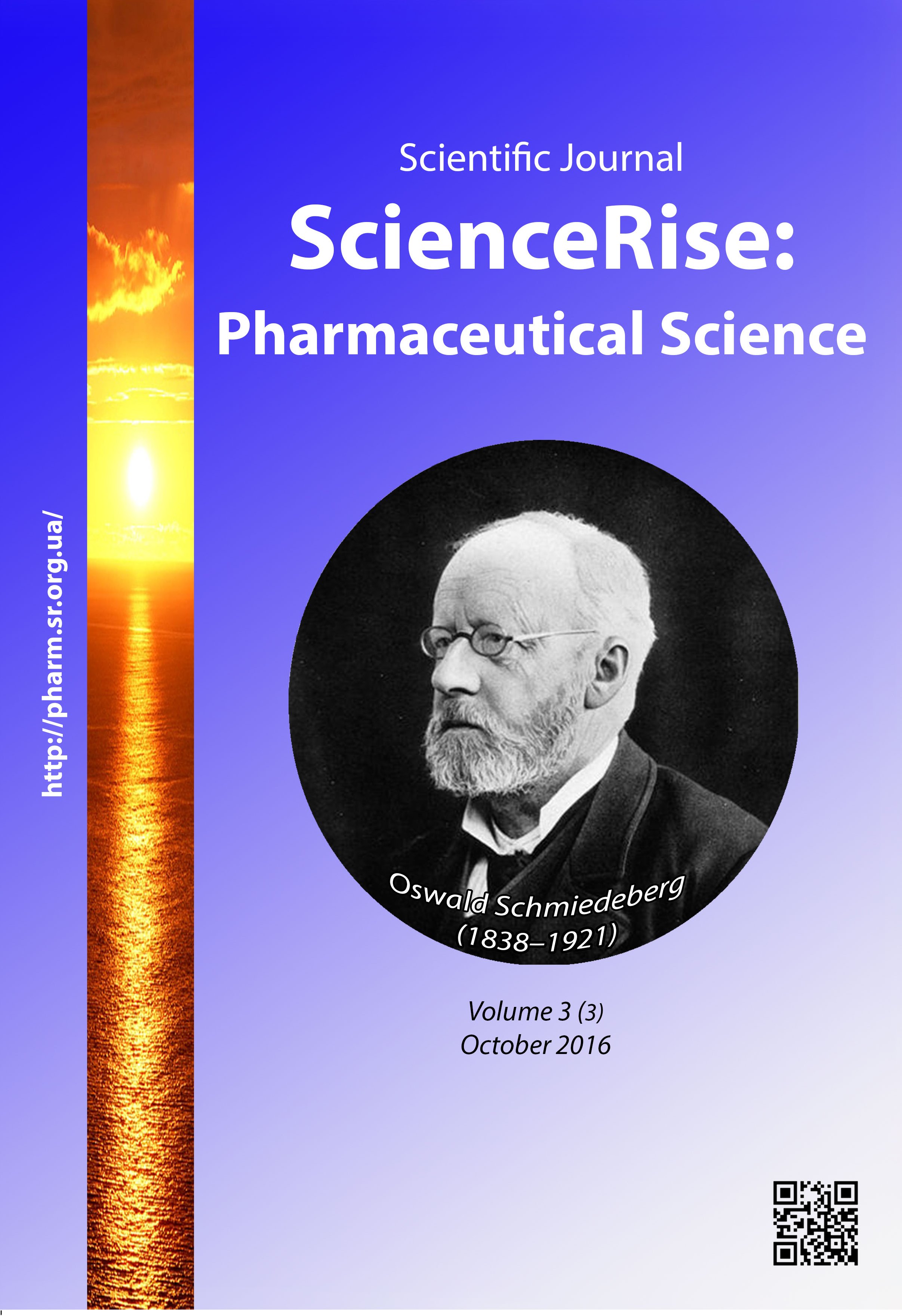Ідентифікація та визначення кількісного вмісту стероїдних сполук у сировині рогозу вузьколистого
DOI:
https://doi.org/10.15587/2519-4852.2016.79473Ключові слова:
рогіз вузьколистий, листя, плоди, кореневища, корені, стероїдні сполуки, спектрофотометрія, якісні реакціїАнотація
Typha angustifolia L. (рогіз вузьколистий) – рослина, яка широко розповсюджена на території України у вологих місцях, зокрема по берегах річок, болотяних місць тощо. Сировина рогозу в народній медицині застосовується для лікування багатьох захворювань. Одним з показань до застосування сировини рогозу є запальні процеси. Оскільки відомо, що виражену протизапальну активність проявляють стероїдні сполуки, доцільно було комплексно дослідити рогіз на вміст даної групи речовин та виявити якісний склад і визначити кількісний вміст стероїдних сполук у листі, плодах, кореневищах та коренях рогозу вузьколистого.
Метою даної роботи було ідентифікація та визначення кількісного вмісту стероїдних сполук у листі, плодах, кореневищах та коренях рогозу вузьколистого.
Методи дослідження. Ідентифікацію стероїдних сполук проводили за допомогою якісних реакцій. Кількісний вміст суми стероїдних сполук у сировині рогозу вузьколистого визначали спектрофотометричним методом.
Результати дослідження. В результаті проведеного дослідження в листі, плодах, кореневищах та коренях рогозу вузьколистого було встановлено наявність стероїдних сполук. Аналізуючи отримані дані стосовно кількісного вмісту суми стероїдних сполук у досліджуваних видах сировини встановлено, що вміст даного класу речовин домінував у листі рогозу, дещо менше – у кореневищах, слідові кількість – у плодах.
Висновки. Результати даного експерименту можуть бути використані при розробці та одержанні субстанцій та нових фітозасобів з даних видів сировини, а також при визначенні параметрів стандартизації сировини рогозу вузьколистого
Посилання
- Kapitonova, O. A., Platunova, G. R., Kapitonov, V. I. (2012). Rogozy Vjatsko-Kamskogo kraja. Izhevsk: Izd-vo «Udmurtskij universitet», 190.
- Umesh, M. K., Sanjeevkumar, C. B. (2014). Evaluation of in vitro anti-thrombolytic activity and cytotoxicity potential of Typha angustifolia L. leaves extracts. International Journal of Pharmacy and Pharmaceutical Sciences, 6 (5), 81–85.
- Padalia, H., Chanda, S. (2015). Comparative phytochemical analysis of aerial parts of A. procumbeans, F. dichotoma, S. sponteneum, S. nigra and T. Аngustifolia. Journal of Pharmacognosy and Phytochemistry, 4 (2), 11–16.
- Rao, M. R. K., Saranya, Y., Divya, D. (2016). Preliminary Phytochemical Analysis of Typha domingensis Rhizome Aqueous Extracts. Int. J. Pharm. Sci. Rev. Res., 37 (1), 30–32.
- Islam, F., Hossain, A., Hossain, M. G., Murshid, G. M. M., Rahman, M. M. (2015). Evaluation of Antioxidant, Analgesic and Cytotoxic Activities of Typha angustata L. Root. Dhaka University Journal of Pharmaceutical Sciences, 14 (1), 55. doi: 10.3329/dujps.v14i1.23736
- Juvekar, A., Bidikar, M., Juvekar, P., Varpe, S. (2012). Evaluation of anti-inflammatory activity of Typha angustifolia pollen grains extracts in experimental animals. Indian Journal of Pharmacology, 44 (6), 788. doi: 10.4103/0253-7613.103303
- Fruet, A. C., Seito, L. N., Rall, V. L. M., Di Stasi, L. C. (2012). Dietary intervention with narrow-leaved cattail rhizome flour (Typha angustifolia L.) prevents intestinal inflammation in the trinitrobenzenesulphonic acid model of rat colitis. BMC Complementary and Alternative Medicine, 12 (1). doi: 10.1186/1472-6882-12-62
- Patel, S. S., Savjani, J. K. (2015). Systematic review of plant steroids as potential antiinflammatory agents: Current status and future perspectives. The Journal of Phytopharmacology, 4 (2), 121–125.
- Della Greca, M., Monaco, P., Previtera, L. (1990). Stigmasterols from Typha latifolia. Journal of Natural Products, 53 (6), 1430–1435. doi: 10.1021/np50072a005
- Della Greca, M., Mangoni, L., Molinaro, A., Monaco, P., Previtera, L. (1990). (20S)-4α-methyl-24-methylenecholest-7-en-3β-ol, an allelopathic sterol from Typha latifolia. Phytochemistry, 29 (6), 1797–1798. doi: 10.1016/0031-9422(90)85019-c
- Pawar, C. R., Kolche, V. N., Khedkar, P. A. (2011). Anti-inflammatory activity of leaves of Typha angustata (Typhaceae). International Journal of Research in Ayurveda and Pharmac, 2 (5), 1598–1600.
- Kyslychenko, V. S., Zhuravel', I. O., Jaroshenko, I. V., Terninko, I. I., Burda, N. Je., Kyslychenko, O. A. et. al. (2009). Patent na korysnu model' № 41309, MPK G01N 33/15. Sposib kil'kisnogo vyznachennja steroi'div ta flavonoi'div biologichno aktyvnyh rechovyn roslynnogo pohodzhennja. № u 200900463; declareted: 22.01.2009; published: 12.05.2009, Byul. № 9.
##submission.downloads##
Опубліковано
Як цитувати
Номер
Розділ
Ліцензія
Авторське право (c) 2016 Євгеній Олександрович Довгаль, Ірина Геннадіївна Гур’єва, Вікторія Сергіївна Кисличенко, Ірина Олександрівна Журавель

Ця робота ліцензується відповідно до Creative Commons Attribution 4.0 International License.
Наше видання використовує положення про авторські права Creative Commons CC BY для журналів відкритого доступу.









